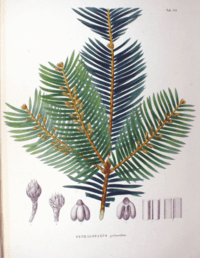Cephalotaxus harringtonii
| Cephalotaxus harringtonii | |
|---|---|
| Close-up of a specimen in the Botanical Garden in Berlin | |
| Scientific classification | |
| Kingdom: | Plantae |
| Division: | Pinophyta |
| Class: | Pinopsida |
| Order: | Pinales |
| Family: | Cephalotaxaceae |
| Genus: | Cephalotaxus |
| Species: | C. harringtonii |
| Binomial name | |
| Cephalotaxus harringtonii (Forbes) K. Koch | |
Cephalotaxus harringtonii, commonly known as Korean plum yew,[2] Japanese plum-yew,[3] Harrington's cephalotaxus,[4] or cowtail pine, is a coniferous bush or small tree in the plum yew family. It is native to Japan, but is occasionally utilised in western gardens and several cultivars exist for these purposes. Japanese plum yew has been in cultivation in Europe since 1829, and many modern horticulturists are familiar with this Japanese species, named in honor of Charles Stanhope, 4th Earl of Harrington, one of the first to grow the plant in a European garden, at Elvaston[5].
Description
New shoots of C. harringtonii remain green for three years after forming and have ribs at the leaf bases. The buds are green in colour, globular in shape and very small at only 1 mm in length. There is one rank of leaves present on either side of the shoot, and these rise up above it and curve slightly inwards, forming a narrow V-shape somewhat akin to a dove's wings. The ranks are often vertical, but can be more flattened in shaded parts. The leaves are broadly linear in shape and measure about 5 cm long by 0.3 cm wide. They are abruptly pointed at the apex, leathery in texture and a bright matte yellowish-green on the upper-surface. The abaxial surface, or underside of the leaves, shows two broad, pale to silvery stomatal bands.[6]

The species is dioecious and the male plants are typically densely covered with pairs of flowers that are pale cream in colour, though they become brown with time, and globular in shape. They are borne on 2 to 4 mm stalks beneath each pair of leaves. Pollen is released from March until May. The female individuals have two pairs of knob-like globose flowers that appear on curved stalks at the bases of the shoots. The fruit is obovoid in shape and measures 2.5 cm long by 1.5 cm wide. They are a smooth and pale green ín colour with dark green stipes, though when ripe they turn brown.[6]
Taxonomy
The Japanese plum yew was first considered to be a yew when it was partially described by Thomas Andrew Knight in 1839 and as such was named Taxus harringtonii. It was reclassified by Philipp Franz von Siebold and Joseph Gerhard Zuccarini in 1846 with a new specific name, Cephalotaxus drupacea. Some botanists consider C. koreana and C. sinensis to be synonymous with C. harringtonii.[7] Although normally found under the name Cephalotaxus harringtonia, that name violates the grammar rules of Botanical Latin and in 2012 was corrected to Cephalotaxus harringtonii. However, this opinion is still not universally accepted by taxonomists and therefore it is acceptable to use Cephalotaxus harringtonia until a definitive position has been agreed.
Range and habitat
Cephalotaxus harringtonii is present in Japan. Within Japan, the tree ranges from Kyūshū in the south to Hokkaidō in the north. More specifically, it is found in Hondo in the Chiba Prefecture on Mount Kiyosumi, which is located in the Awa District within the Awa Province. It is also found in the Nagasaki Prefecture and the Hiroshima Prefecture. The variety nana is found in eastern Honshū as well as Hokkaidō, most notably on seaside cliffs and in mountainous areas.[8] They thrive in partial shade on deep, rich soils.[7]
Cultivation
Cephalotaxus harringtonii has been in cultivation in the United Kingdom since 1829 and is infrequently encountered as a garden specimen. Of the several species that exist in the genus, the Japanese plum yew is the one most often encountered in western gardens.[7] Several cultivars exist:
- 'Fastigiata' was first selected in 1861 in Japan. It grows to 6 metres in height and it characterised by its broad cluster of erect stems and very dark green leaves that spread all around the stem and are strongly decurved. The shoots are unbranched in the upper parts of the plant, while the lower parts have somewhat chaotic projecting side-shoots that hang down and contain leaves in flat ranks. The flowers are also inconspicuous.[6]
 'Fastigiata' plant with a chaotically projecting side-shoot
'Fastigiata' plant with a chaotically projecting side-shoot Cephalotaxus harringtonii 'Fastigiata'
Cephalotaxus harringtonii 'Fastigiata'
Pharmaceutics
Omacetaxine, a substance derived from the leaves of this plant, is a novel (as of 2008) anti-leukemia drug.[9]
References
- ↑ Conifer Specialist Group 2000 (2006). "Cephalotaxus harringtonii". IUCN Red List of Threatened Species. Version 2006. International Union for Conservation of Nature. Retrieved 11 June 2007.
- ↑ English Names for Korean Native Plants (PDF). Pocheon: Korea National Arboretum. 2015. p. 404. ISBN 978-89-97450-98-5. Archived from the original (PDF) on 25 May 2017. Retrieved 17 December 2016 – via Korea Forest Service.
- ↑ "BSBI List 2007". Botanical Society of Britain and Ireland. Archived from the original (xls) on 2015-01-25. Retrieved 2014-10-17.
- ↑ "Cephalotaxus harringtonia". Natural Resources Conservation Service PLANTS Database. USDA. Retrieved 16 January 2016.
- ↑ www.derbyshire.gov.uk :Elvaston Gardens
- 1 2 3 Mitchell, Alan (1974). Trees of Britain & Northern Europe. London: Harper Collins Publishers. p. 54. ISBN 0-00-219213-6.
- 1 2 3 Earle, Christopher J. (2006). "Cephalotaxus harringtonia". The Gymnosperm Database. Archived from the original on 2007-04-05. Retrieved 2007-06-11.
- ↑ Tripp, Kim E. (1995). "Cephalotaxus: the plum yews". Arnoldia. Harvard University Press. 55 (1): 24–39.
- ↑ Bennett, Simeon (2008-04-03). "ChemGenex Poised for Rebound With Merck-Beating Drug (Update4)". Bloomberg. Archived from the original on February 13, 2015.
| Wikimedia Commons has media related to Cephalotaxus harringtonii. |
